In the Soil that Nurtures Us A Certain Death to the Colonial Myth
Introduction
As I write, more than one year has passed since the murder of George Floyd in Minneapolis, Minnesota on 25 May 2020. Floyd, a Black man, was pinned to the ground by White police officer Derek Chauvin on suspicion of using a counterfeit twenty-dollar bill.1 Footage taken by bystanders shows the officer pressing his knee into the back of Floyd’s neck for almost nine minutes as Floyd pleaded “I can’t breathe.” The footage ignited worldwide protests under the banner of Black Lives Matter (BLM). The protests were not only about Floyd, who is one of many African Americans killed by police violence, rather the footage of his cruel death was a lightning rod for an overwhelming anger and resentment that has been growing throughout the five-hundred-year history of structural racism and White supremacism that showed no sign of abating.
The BLM protests in 2020 confirmed Walter Benjamin’s insight that as much as the victors want the truth of their past to disappear with the dawn of every new day, these past truths will repeatedly flash up unexpectedly to illuminate any new emergency. “To articulate what is past,” wrote Benjamin as he fled the Nazi advance in 1940, “means to take control of a memory, as it flashes in a moment of danger.”
The subject of this essay is such returns of past historical injustices in present-day Australia. The BLM protests triggered by Floyd’s murder, which swept the globe like a raging flood, quickly spilt over into the bitterness felt towards monuments celebrating European colonialism. It had been building since the 2015 Rhodes Must Fall campaign, but in truth it was only a recent manifestation of a longer history of iconoclasm.
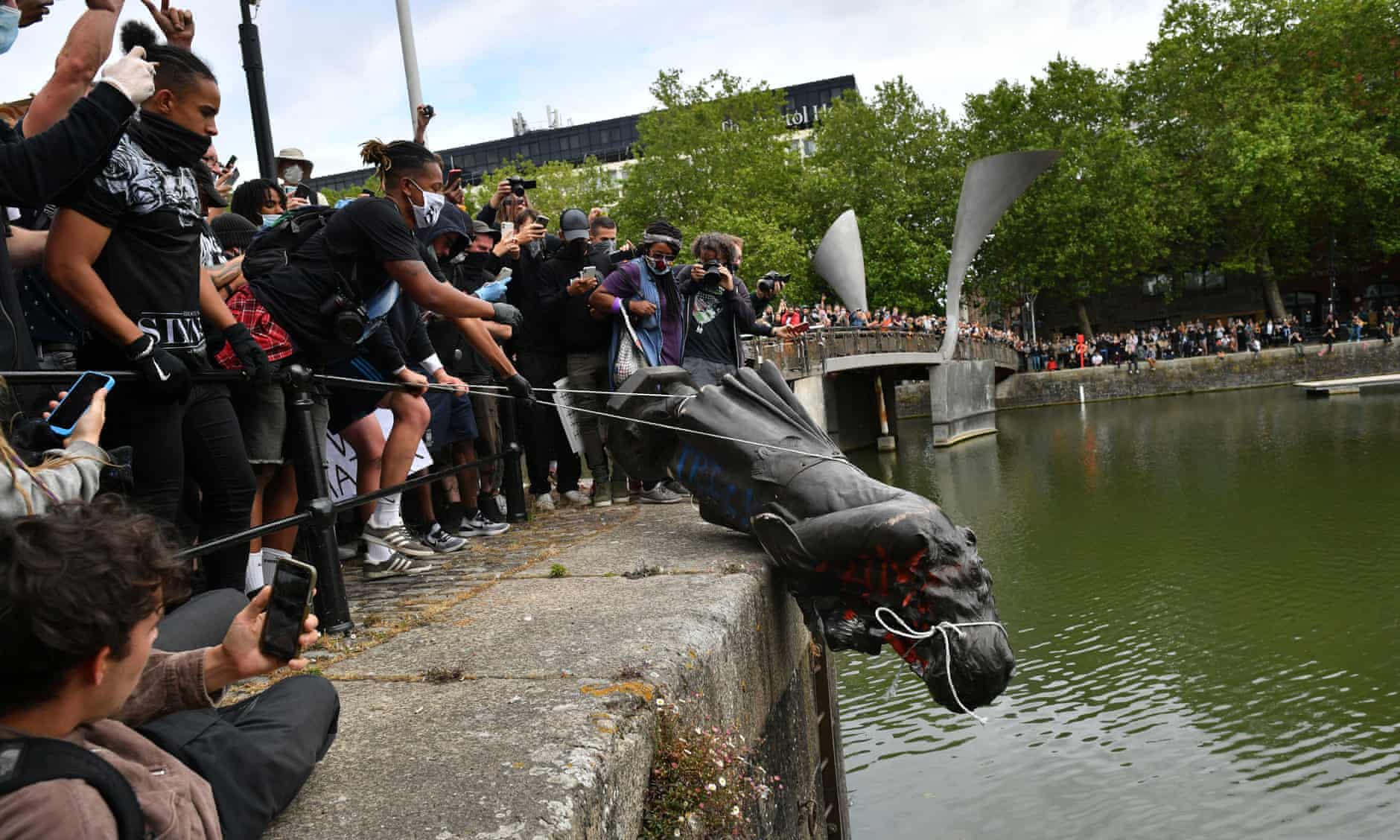
On 7 June 2020, a statue of the seventeenth-century British slave trader and Tory politician Edward Colston was toppled during a BLM protest in Bristol (fig. 1).2 The world watched the demonstrators remove the statue, roll it through the city and into the harbor. Also in June, a monument of King Leopold II in Ostend was vandalised during a BLM protest, and two others were removed in Antwerp and Ghent after protesters called for an answer to the celebration of the former sovereign, while demonstrating against police brutality in Belgium.3 The statues were indefinitely placed in Belgium’s Middelheim Museum and Ghent City Museum respectively. Across the US, hundreds of monuments to colonialists and confederates were toppled and removed. In contrast, in France, as protestors gathered en masse, President Emmanuel Macron opposed the removal of colonial monuments, stating: “the Republic will not erase any trace, or any name, from its history.”4 Despite this, across continental France and the l’Outre-mer department of Martinique, many monuments and memorials were damaged and toppled.5
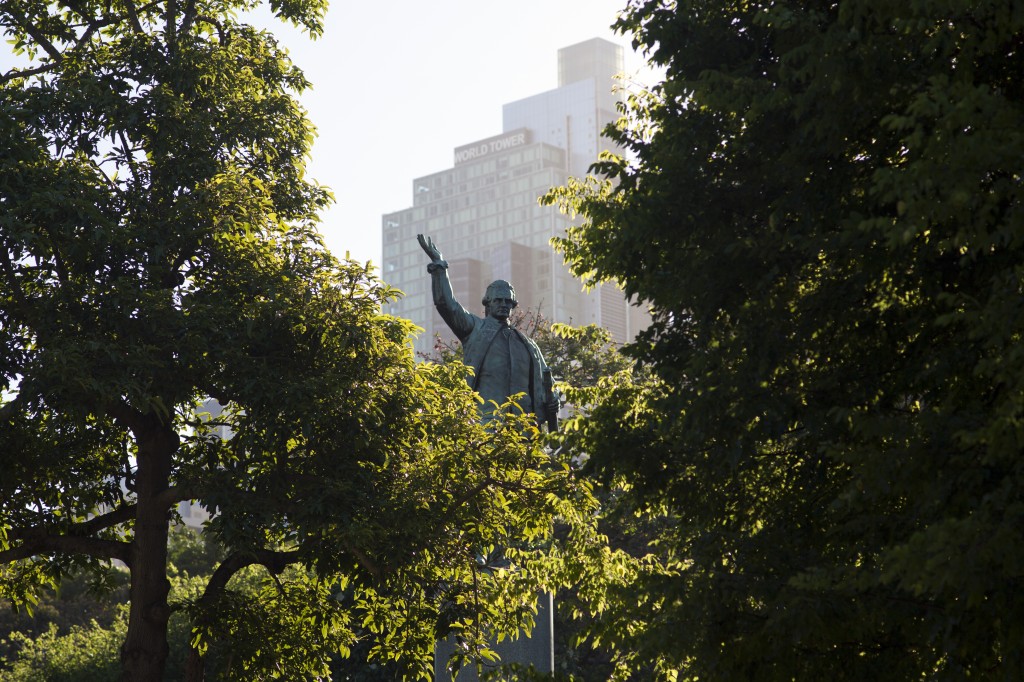
In Australia, Thomas Woolner’s (1825–1892) sculpture of Captain Cook in Hyde Park, Sydney, was placed under police protection (fig. 2) in anticipation of its potential vandalization and toppling by protesters who had organised a rally on 12 June.6 This was just one day after Prime Minister Scott Morrison, displaying his ignorance of Australian history, responded to local BLM protests by stating that “there was no slavery in Australia.”7
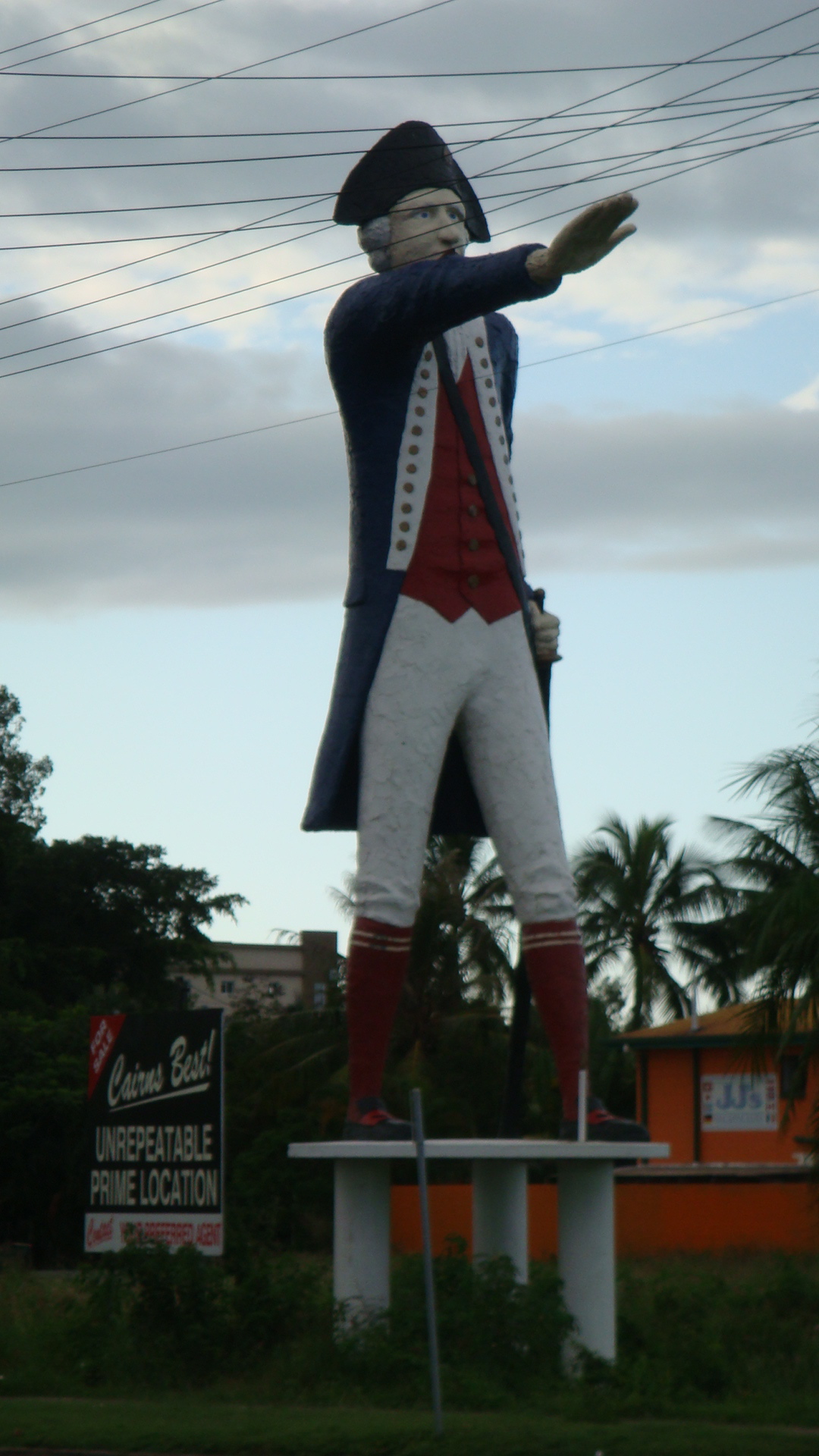
The police protection of Woolner’s statue guards more than an icon of colonial heritage; it also reasserts the sovereignty Cook claimed for the British Crown over the east coast of Australia in accordance with the doctrine of discovery and the theory of terra nullius, including all that it excluded from the colonial gaze. Woolner’s statue is tethered to the dreams of a White nation, which established the Australian settler-nation-state today.8 This symbolic value is the principal reason why Woolner’s statue has long been the target of protests by Indigenous activists.
If art can memorialise it also can counter-memorialise. In their recent article demonstrating how art has challenged the spectres of fascist histories, Cristina Buta and Charles Esche argue that there is a contradiction in the West denouncing genocide at the hands of fascist European governments without recognising the impact of their genocidal colonial regimes.9 They position Hans Haacke’s And You Were Victorious After All (1988) (fig. 5)—which recreated a Nazi victory column fifty years after the annexation of Austria by Germany10—as a response to the rise of Neo-Nazism in the late 1970s.11 Yet they are critical of the failure of European responses to fascism. Instead of linking fascism to colonialism, and thus to the Western project, fascism has been used as a scapegoat for the wrongs of European regimes. Buta and Esche argue that the “never again” imperative has been exclusively applied to Nazi Germany (and things that it aesthetically resembles). As such, the colonial matrix of power that produced White supremacy has generally been taken out of the equation.12 In this sense, monuments are there as a marker of public remembrance so they can change the nature of what is remembered. Buta and Esche argue there is “scarcity and incompleteness of artistic responses realised as public art to address European racism and white supremacy.”13
Buta and Esche’s essay is not only a plea to resist the normalisation of far-right discourse and White supremacism but also a call to arms for contemporary artists and cultural produces to actively oppose it through art. In the context of colonial Australia, this raises the main question of the present article: What should we do with Woolner’s Cook? To answer this question, I contend that we must first understand why Woolner’s monument has value and for whom it is considered valuable. Without understanding the source of its value, we cannot fully understand its material significance.
Monuments, Nation-States and Settler Sovereignty
The Venice Charter (1964) sets forth the principles for the conservation and restoration of monuments. It states that monuments are “imbued with a message from the past” and that they serve as “witnesses” to a “common heritage.”14 Given the ongoing debate concerning the value of colonial heritage in Australia, a 2018 report published by the Australian Heritage Council outlined the perceived threats to colonial monuments, including “lack of awareness, appreciation and respect … resulting in purposeful damage or disintegration through neglect,” and recognised that monuments “are a reflection of a point in time that was almost exclusively focused on values of settlers.”15 What is the symbolic heritage value of Woolner’s statue of Captain Cook for the modern nation-state of Australia?
The commissioning of Woolner’s statue was an early manifestation of settler nationalism that began to form from the mid-nineteenth century, maturing over the next fifty years in a period of widespread massacres of Indigenous populations as the invasion spread across most of the Australian continent.16 The leading political figure in Colony of New South Wales and champion of this emerging nationalism during the second half of the nineteenth century, Sir Henry Parkes, played a central role in commissioning Woolner to make the statue (and many other colonial statues that adorn Sydney’s parks and buildings). A proposed Cook monument was first funded by public subscription in 1869 in the lead up to the centenary of his Cook’s claim of sovereignty in 1770. Following the lack of public support, Parkes took the “matter into his own hands” by commissioning Woolner and supplementing the dwindling funds with government grants.17 Ten years after Woolner’s sculpture was unveiled in Hyde Park in 1879—by then celebrating the centenary of Cook’s death in 1779—Parkes made his famous Tenterfield speech at the School of Arts in which he called for the federation of the colonies. Parkes, who became known as the “Father of Federation,” long campaigned for the unification the settler population by advocating an homogenously Anglo-Saxon unit that he affectionally called “Australian Britons.”18
Thomas Woolner was a British sculptor and co-founder of the Pre-Raphaelite Brotherhood. He had visited Australia in 1852 and stayed until 1854, during which time he forged a strong friendship with Parkes.19 At the time, Parkes ran the newspaper Empire (1850–1875) and became a member of the Legislative Council for Sydney in 1854.20 Their comradery continued throughout their life. Parkes understood the power of art and monuments in developing the nascent nationalism of the colonies. The sculptor’s daughter, Amy Woolner, wrote that:
The idea appealed very strongly to the Sculptor, who had a great admiration for the discoverer [Cook]; and having himself spent many months in Sydney when a young man, knew the position the proposed statue was to occupy, and felt the keenest inclination to undertake the commission.21
The monument is regarded as one of Woolner’s major artworks. First exhibited in Waterloo Place, London, it was later transported to Sydney and unveiled at Hyde Park on 25 February 1879 before a crowd of approximately 60,000.22 During its unveiling, Governor Sir Hercules Robinson gave a speech in which he said: “it would be well for the youth of Australia to imitate his [Cook’s] nobility of character.”23 At the time, there was nothing controversial about such a claim. For Parkes, the monument was a way to bring the past into the present by celebrating Cook for having “Discovered this territory”—as it is inscribed on the monument—which in turn cultivated settler belonging by not only creating a national heritage but also a national origin story.24
Motivated by a desire to promote independence and distinguish Australia as a proud dominion of the Empire,25 in his Tenterfield speech Parkes, himself a poet, recited a poem by Queensland poet Brunton Stephens who expressed hurried anticipation of becoming a Dominion of the Empire, writing:
Not yet her day! How long? Not yet!
There comes her flush of violet!
And heavenward faces all aflame
with sanguine imminence of morn
wait but the sun’s kiss to proclaim
The day of the Dominion born.
Anglo-Saxon settlers naturally defined themselves in relation to Britain.26 This did not change during the intensifying nationalisation throughout Europe following the so-called Spring of Nations of 1848. Independence from Britain was on the table in Australia, but Parkes, who was inspired by the spirit of nationalism, was instrumental in setting an agenda that imagined Australia as an Anglo-Saxon hegemony in which: “We are all one family, one blood, one race,”27 unified through Empire in 1905 by what the English journalist Richard Jebb described it as “colonial nationalism.”28 The Anglo-centric vision Parkes imagined in the notion of Australian-Britons rested on the genocide of the continents First Nations peoples whose sovereignty Cook, the British Crown, and the settler colonists denied. First Nations resistance to the invasion continued against the structures of settler-colonialism which asserted terra nullius. The state protection of the Cook statue in Hyde Park demonstrates its continuing function as a mythmaking instrument that perpetuates the ideology of terra nullius. If a function of remembering is also to forget, Woolner’s sculpture forgets by way of shielding itself from the memory of what Cook and the settler-nation forgot.29
Counter-Colonialism and Counter-Memorialisation
That the sins of colonialism have not been appeased or redeemed is evident in their continuing return through the contestation of colonial monuments. In the past century, the commemoration and valorisation of colonisers such as Captain James Cook and Lachlan Macquarie, or Captain Arthur Phillip who led the First Fleet which established the first colony in 1788, has been contested by First Nations peoples.
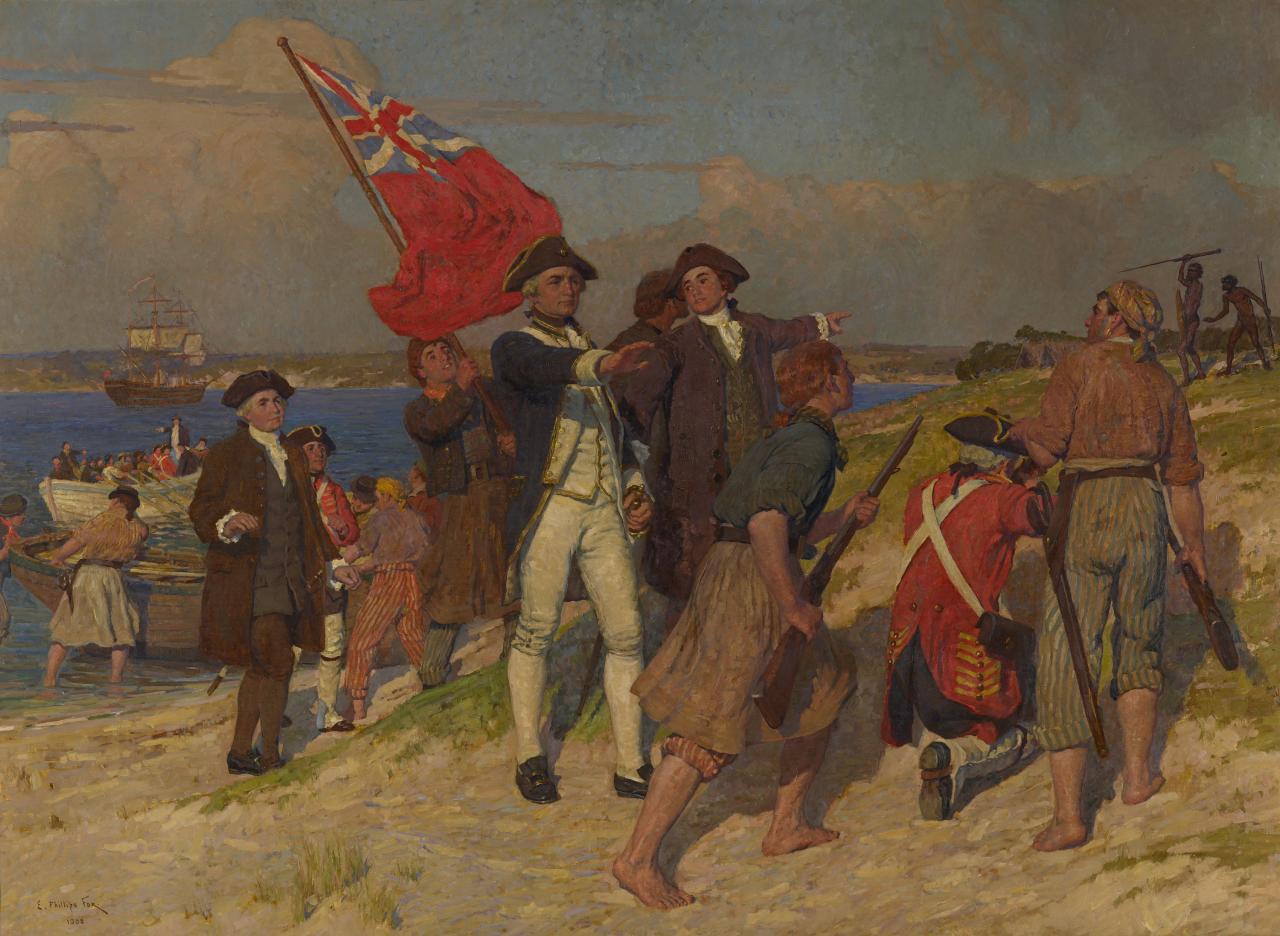
As a direct response to the official decision to hold an extravagant sesquicentennial celebration of the founding of the first colony in 1938, “Australia Day” was declared a “Day of Mourning” by Yorta Yorta activist William Cooper.30 During the 1960s, the Redfern Black Caucus would regularly deface Woolner’s statue of Captain Cook in Hyde Park.31 In April 1970, Black Power figure and then director of the Aboriginal Advancement League, Bruce McGuinness called for a boycott to visiting Captain Cook’s cottage during the bicentenary celebrations of the HMS Endeavour’s arrival to Botany Bay and organised picketing to surround the cottage in Fitzroy Gardens to prevent entry.32 In 1972, the cottage was “daubed” in response to the eviction of the Aboriginal Embassy in Canberra.33 In 1988, the largest known Pan-Aboriginal gathering in the history of First-Nations Australia occurred with over 50,000 protesters gathering in Sydney to oppose the official bicentenary celebration of Phillip’s invasion.34 In 1991, in a comic demonstration of the power of symbolism and statues, Robbie Thorpe and Gary Foley put a monument of John Batman on trial for his involvement in genocide in Melbourne.35 More recently, on the Day of Mourning in 2018, both Cook and Macquarie in Hyde Park were spray-painted with two well-known and widely rotated anti-colonial axioms: “change the date” and “no pride in genocide”. Then Prime Minister Malcolm Turnbull called the acts “Stalinist,” and the current Prime Minister Scott Morrison labelled them a “national disgrace,” adding, rather oddly, that it “does not keep one indigenous child safe, in school or end up in a job. Grow up idiots” (sic).36
Recently, Gary Younge has argued that the notion of memorialising an individual is inherently anachronistic given that “there is no guarantee that any consensus will persist.”37 Though this also points to their purpose: the persistence of a consensus. To question the moral character or intellectual rigor of colonial heroes is to obscure a more consequential epistemological question that concerns the ongoing “colonial matrix of power”.38 This dichotomy was conjured in discussions for the fate of the giant Cook, a ten-metre high, gaudy eye-sore of a statue of Cook in Cairns (fig. 3) which, in its Nazi-like salute, mirrors the depiction of Cook in E. Phillip Fox’s Landing of Captain Cook at Botany Bay, 1770 (1902) (fig. 4).39 The controversial creation of the Captain Cook statue was part of the development of a strip of units commissioned by a private developer in 1972 on Djabugay Country. It is regularly ridiculed for both its evocation of a Nazi Salute and its ugliness, but not how its symbolic value in the settler myth.40 Defending the statue, local Liberal Party Member of Parliament Warren Entsche pointed to the scientific significance of Cook’s voyage,41 perpetuating the narrative that Cook brought knowledge based in Enlightenment thinking, and with it, civilisation.
Colonialism is Fascism: An aesthetic Analysis
Contestation
The aesthetic and historical arguments concerning the value of colonial monuments was raised in an open letter written by curator and writer Nicholas Tammens and writer Tristen Harwood, co-signed by Australian art historians and arts workers, and published in the Saturday Paper on 4 July 2020 at the height of the BLM protests. The letter argued for the relocation of Woolner’s Cook to a museum, contending that Cook is a “consequential figure in the story of British imperialism, Indigenous dispossession and the nation’s foundations.”42 In the context of a museum, they argued, the monument would enable broader Australian society to question “how public works of art can be revalued” and challenge “our attachments” to colonial figures.43
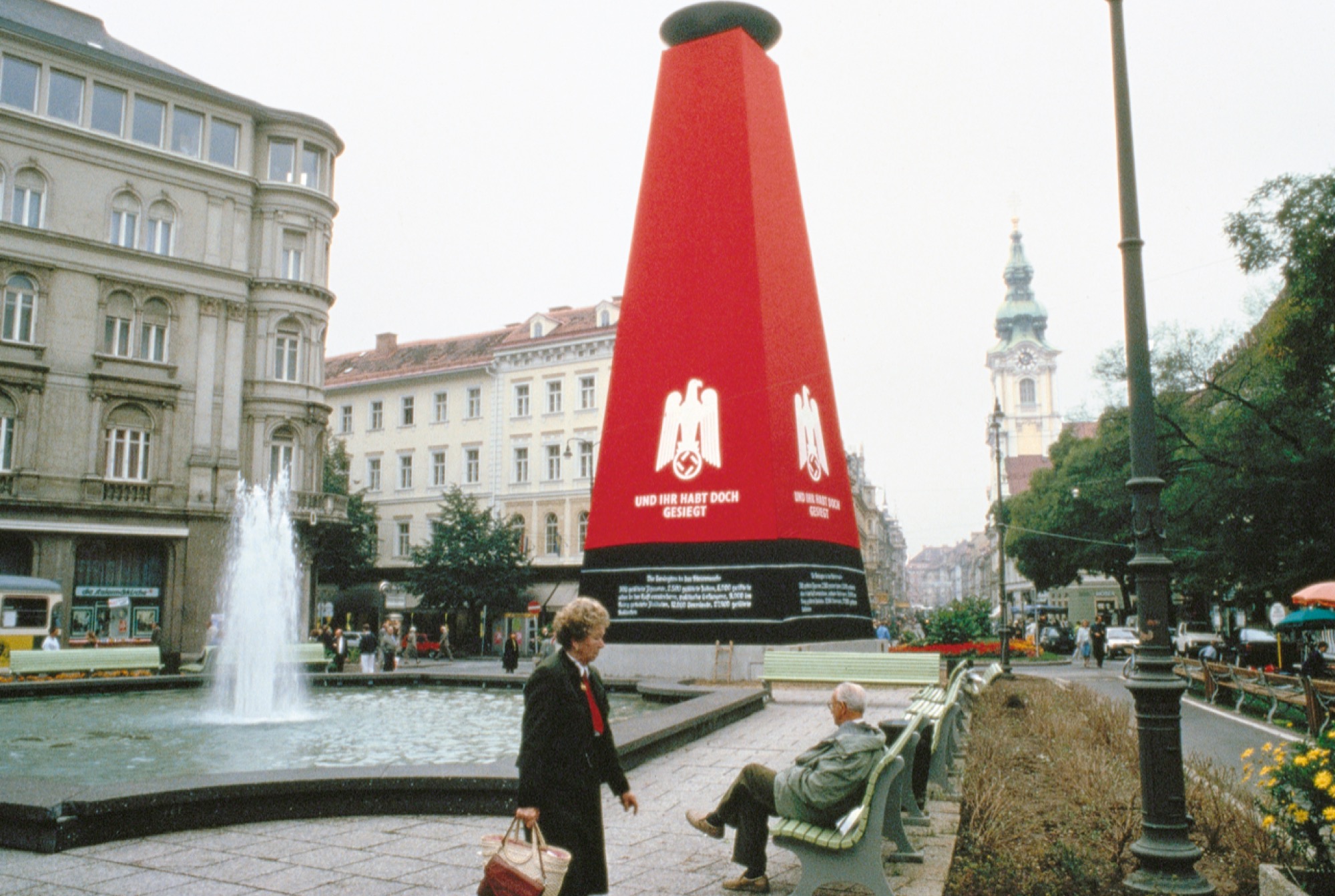
Colonial heritage protection complicates the proposed relocation of the monument due to the value of site specificity. Woolner’s Cook was intended for Hyde Park and the principles and practices for the protection, preservation, and management of Australian places of cultural significance that are codified in the Burra Charter links the value of an object to its connection to its original site. The Charter, which was published by the International Council on Monuments and Sites, states that the preservation of monuments is “based on respect for original material and authentic documents” (Article 9) and that “Contents, fixtures and objects which contribute to the cultural significance of a place should be retained at that place” (Article 10).44 Though the Charter recommends the repatriation of Indigenous cultural material, given that it “may be essential to the retention of its cultural significance,” it does not recognise, as if it was imperceptible, colonial cultural heritage.45
Tammens and Harwood’s letter recognises that Woolner’s Cook is a colonial cultural object, and for this reason they argue it should be removed from the context for which it was intended (Hyde Park) so as to disrupt the mystique that it garners in its preservation. Relocation to a museum context, however, begs the question at the heart of the Cook issue because public museums, like public parks, remain functions of the state.46 Museums are, moreover, institutions for the fortification of cultural objects. This is the juncture at which the keep and remove argument intersect. On the one hand, to relocate the monument to a museum would begin a new chapter in conversation with the state. On the other hand, the Charter’s notion of conservation guided the New South Wales government to deploy the police to protect it from altercation.
Counter-Colonial Memorialisation
In memorialising Aboriginal lives lost since colonisation, the Aboriginal Memorial (1987–1988) (fig. 6) resists colonial ideology by rendering visible what it, as expressed in the triumphalist narratives of the nation-state, occludes, or makes invisible.
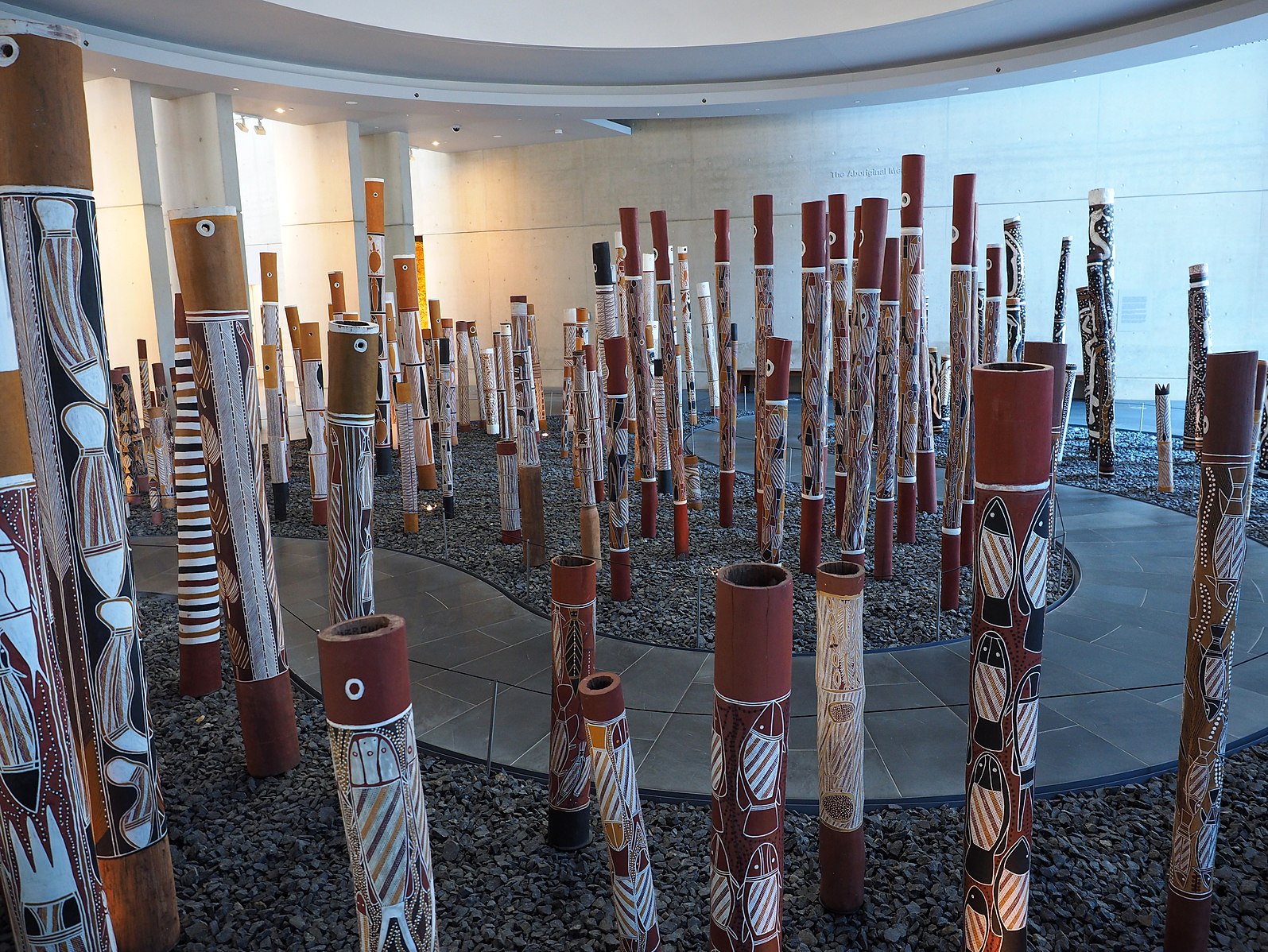
Conceived by Bundjalung artist and curator Djon Mundine, the Aboriginal Memorial was a collaborative project involving forty-three mainly Yolngu artists associated with the art centre at Ramingining in the Northern Territory.47 The Biennale coincided with the bicentenary celebration of the First Fleet which, like other aspects of the celebration, were boycotted by First Nation artists.48 In choosing to exhibit the Memorial, like the large protests Mundine made visible what the celebrations brushed over.49 In the context of the nationalist 1988 bicentenary celebrations, Mundine stated “the bind was to present Aboriginal culture without celebrating—to make a true statement.”50 The Memorial consists of two hundred hollow cylindrical log coffins.51 Visitors are invited to walk through the Memorial on a path that contours the Glyde River, which is a major Dreaming and also massacre site of the Ramingining area. The Memorial was acquired by the National Gallery of Australia (NGA) in 1988, where it is now on permanent display at the entrance of the gallery.
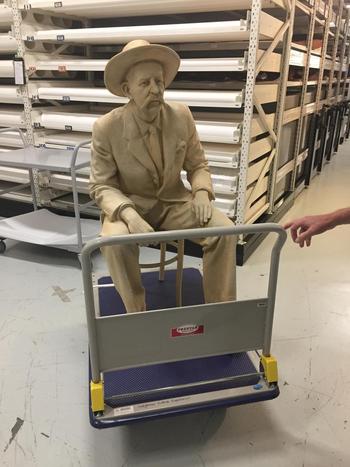
Demonstrated earlier in Haacke’s work, appropriation is also a way to counter-memorialise. A well-known example is Daniel Boyd’s parody of Fox’s romantic depiction of Cook arriving at Botany Bay in Landing of Captain Cook at Botany Bay, 1770 (1902). In We Call Them Pirates Out Here (2006) (fig.7), Boyd depicts Cook as a pirate with an eye-patch, a parrot on his shoulder, and skull-and-bone Union Jack flag as he arrives before an ominous and thunderous sky.
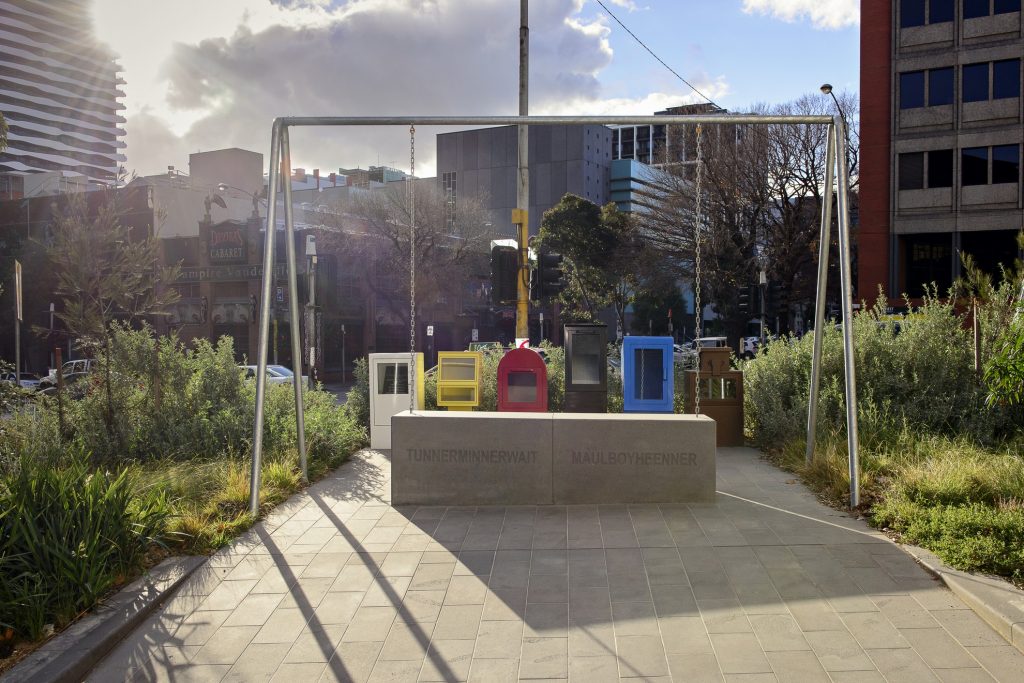
A lesser-known example of counter-memorialisation within the museum context is the prop of anthropologist Baldwin Spencer which was exhibited at Bunjilaka in the Melbourne Museum from 2000 to 2011 (fig. 8).52 The to-scale prop of Spencer was installed on a wicker chair behind a vitrine and surrounded by “everyday objects that [he] and his contemporaries collected, including spears and spear throwers, baskets, smoking pipes, digging sticks, knives, throwing sticks, clubs, neck ornaments and a canoe.”53 The sculpture, which was commissioned by Tony Birch, Lindy Allen, and John Morton, sought to reverse the colonial gaze and make the collector the collected.54
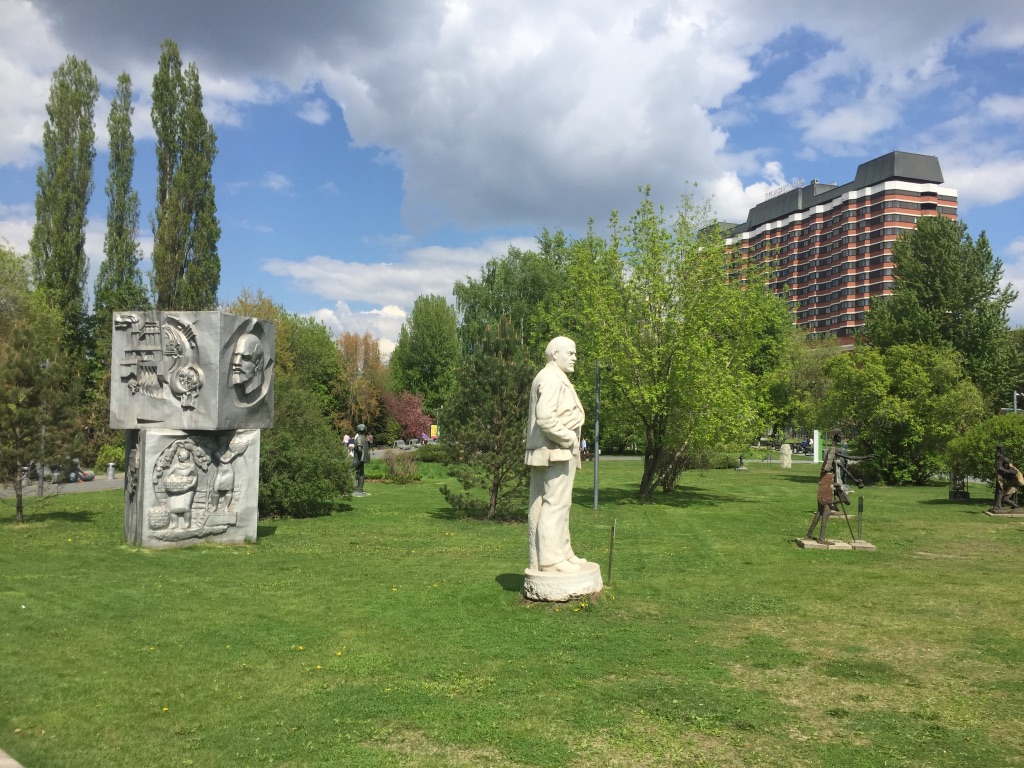
Public art, as Buta and Esche argue, takes on a different function by acting as and for a public memory. Standing by Tunnerminnerwait and Maulboyheenner (2016) (fig. 9) by artists Brook Andrew and Trent Walter was commissioned by the City of Melbourne and installed at the intersection of Franklin and Bowen Streets in downtown Melbourne at the approximate site where Tunnerminnerwait and Maulboyheenner, two Palawa men from Lutruwita (Tasmania, then Van Diemen’s Land), were hanged in Melbourne on 20 January 1842, the first in the history of the Colony since the first permanent settlement of Europeans on Gunditjmara Country.55 Tunnerminnerwait and Maulboyheenner were convicted of the murder of two whale-hunters in 1841.56 The men were in Victoria with the Protector of Aborigines for the Port Phillip district George Augustus Robinson who had travelled with Tunnerminnerwait and Maulboyheenner and three women Truganini, Planobeena (Tunnerminnerwait’s wife) and Pyterruner.57 The Memorial consists of two bluestone markers that are inscribed with Tunnerminnerwait and Maulboyheenner’s names and are connected, almost suspended, by steel chains to gallows that resemble both a gibbet and a swing set. Five brightly-coloured vending boxes sit behind the bluestone markers in which visitors can read text about the Frontier Wars. Surrounding both the gibbet and the vending boxes is a garden of native plants. Andrew referred to the installation as “a war memorial … not rendered in Western fashion.”58
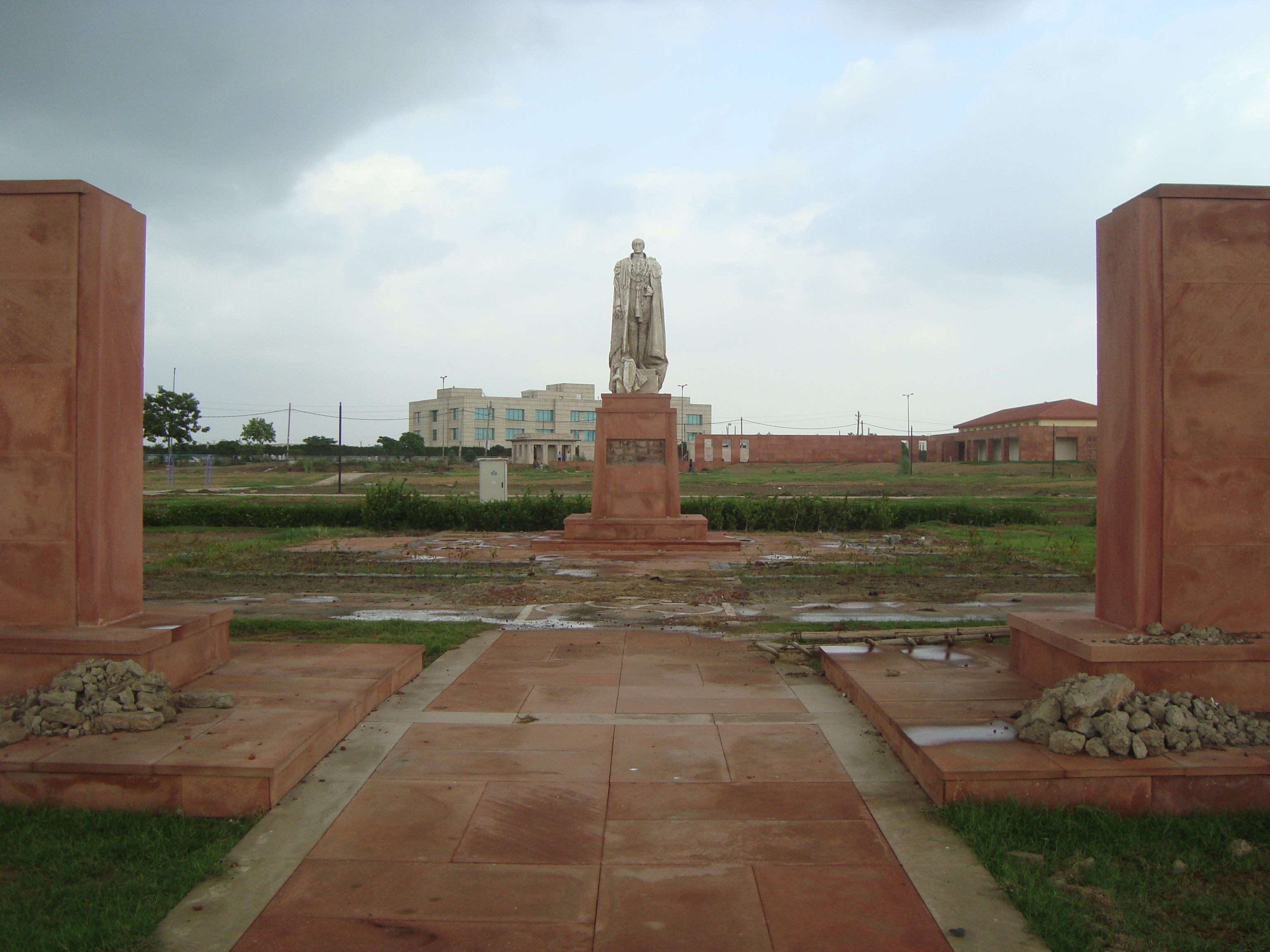
Outside Australia, examples of counter-memorialisation that expose the anachronistic ideologies embedded within a monument’s conservation has been achieved through relocating them and leaving them to ruin. In Moscow, from 1991 onwards, the Fallen Monument Park (fig. 9) included statues of key Soviet political leaders. Here, sculptures and busts of Vladimir Lenin, Joseph Stalin, and Mikhail Kalinin resemble a graveyard of the Union of Soviet Socialist Republics. The Coronation Park in New Delhi is another example (fig. 10). This site is where three British monarchs were exalted as sovereigns of India (Queen Victoria, 1877; King Edward VII, 1903; King George V, 1911) and is now known as the Forgotten Statues of the British Raj. These sites challenge ways of seeing the past by breaking away from a history that was sustained through their contextualisation and preservation. These examples did not emerge as a post-modern anti-foundationalist fantasy but as an axiological imperative of moral consequence for the sovereignty of the nation-state.
Neither of these trajectories have been the fate of Woolner’s Cook. Rather, the statue remains under protection, as if an endangered species. What does this tell us about coloniality today?59
Live Cartography of Colonial Narratives
The history of settler-Australia and its art is a consequence Cook invoking the principles of terra nullius,60 a concept at the origin of the European colonial era that dates back to the mid-1400s and the Inter caetera divinaia,61 which provided the basis for the Doctrine of Discovery and initiated the five-hundred-year history of colonisation. In the natural law tradition that was employed to debate the justice of colonisation, the act of seizing a vacant thing in order to make it one’s own, to the exclusion of everyone else, was called “occupancy.”62 The innate right to occupy vacant land was extended to the sovereign as the universal occupant and moral personality by whom the nation acts.63 The law of nations and the British common law distinguished between settled, ceded, and conquered lands, of which only the first (“settled”) involved the seizing or occupation of otherwise unoccupied land or what nineteenth-century jurists came to increasingly call terra nullius.
Cook invoked these terms when writing in his journal that peoples he observed (Cook does not specify who or where they were) “seem to have no fix’d habitation but move about from place to place like wild Beasts in search of food, and I believe depend wholly upon the success of the present day for their subsistence” and, in addition, that he “never saw one Inch of Cultivated land in the whole Country.”64 To make good the claim according to the law of nations that the occupation of lands is justified if another sovereign does not “cultivate the land” and “avoids labour”—asserting that “the sovereign ought to neglect no means of rendering the land under his jurisdiction as well cultivated as possible”—all the British now needed to do was establish a settlement.65
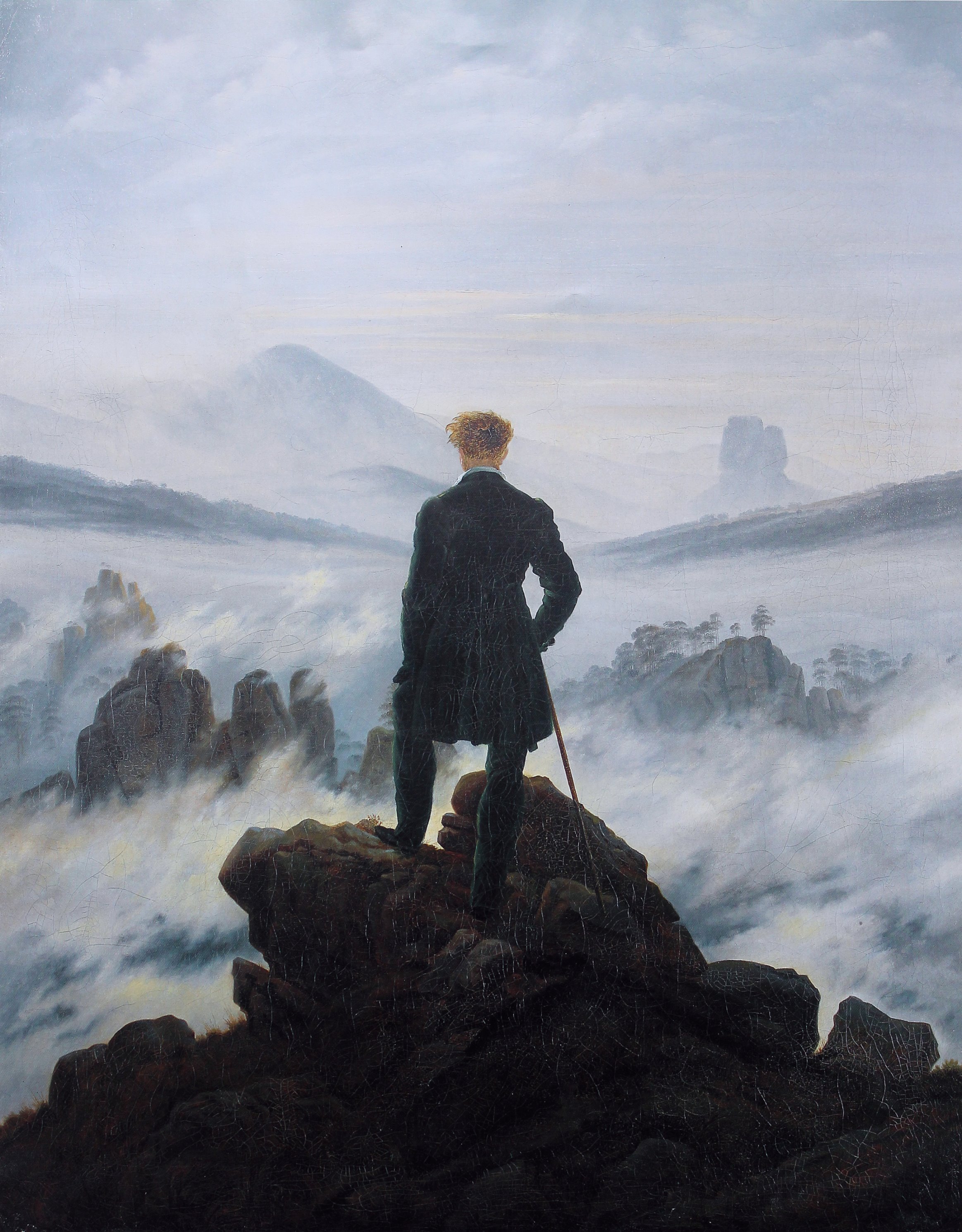
But it would be a mistake to consider Cook’s claims as a mere legal event. What ensued was genocide as the settler colonial blueprint of frontier expansion used by colonists in the Americas was widely applied. To commemorate this in the period of Australian nation-building, Parkes commissioned a monument to represent Cook as an ancestral figure of the new nation. Holding a telescope in his left hand, and with his right hand extended towards the sky, Cook mirrors the romantic imagery that represents the symbiotic relationship between man and nature that was popular in nineteenth-century Romanticism, echoed for example in Caspar David Friedrich’s representation of the sublime in Wanderer above the Sea of Fog (1817) (fig. 11). Imagery like this served two purposes: to evoke the smallness of man in the face of the wildness of nature (the opposite of “man”) and to personify “man”—that is, the Western European man—as an innately curious explorer. Woolner depicts Cook’s so-called discovery as a sublime and God-sanctioned event, rather than an invasion of a sovereign territory.
Cook’s claims on the basis of first discovery and possession were quickly disproven as the early colonists were very conscious of Indigenous existence and resistance. From around the mid-1860s onwards, around the time when Woolner’s Cook was erected, jurists commonly enlarged the idea of terra nullius to include not only “unoccupied land” but also “barbarous country” or “practically unoccupied land” (Advocate-General of Bengal v. Ranee Surnomoye Dossee, 1863) and territory that was occupied by “backward” or “uncivilized” people (Cooper v Stuart Lord Watson, 1889).66 This colonial distinction between “unoccupied” and “occupied” in the definition of terra nullius was referred to in the landmark case Mabo v Queensland (which also overturned it) as the “barbarous” or “absence of law” theory.67
Woolner’s rendering of Cook is important. Its colossuses size mirrors the magnitude of his professed discovery. There is a synergy between the representation of the British being the bringers of law and the protection of Woolner’s sculpture by the police in 2020. Madina Tlostanova and Walter Mignolo have argued that modernity triumphed through Western universal projects including Western Christendom, the Enlightenment, secularisation, and capitalism.68 The commissioning of the monument served to unify the settler population as an independent nation around the symbol of Cook. Cook’s pre-emptive protection by the police connects the security of an order in which the nation-state is directly upheld with the lie of terra nullius which is its origin.
Settler-Colonialism in Action
Settler-colonialism’s myths, be it in Australia or other settler-colonies, demand the elimination of Indigenous sovereignty, which has translated into genocide and dispossession. Australian historian Patrick Wolfe, whose foundational contribution to the field of settler-colonial theory was cautious of simplistic comparisons that reduce and homogenise the experience of occupation,69 said it better than anyone that “invasion is a structure and not an event.”70 For Wolfe, the salient element that links all settler societies is their development of a system of law that is structurally designed to dispossess Indigenous peoples of their pre-existing sovereignty, to legitimise the rights of the settler to exist on stolen land and to disappear Indigenous presence.71 This effort to self-legitimise through law and neutralise Indigenous “externality” (to absorb and assimilate) serves the ultimate goal of the settler-colony, which is to become an imperceptible system of dispossession as well as a legitimate and internationally recognised player in the global community of nation-states.72
In the settler-colony, legal rights trickle down into settler society’s sense of belonging, which in turn propagates the discourses that have been deployed since settlement to further instrumentalise dispossession by creating a cyclical process designed to erase Indigenous sovereignty.
Communities and the sense of belonging to a community are very real, visceral embodied experiences, but they are also underpinned, indeed created, by stories of place and memory, and administered by systems of governance. The systems of legal, social, political, and cultural administration used by nation-states are the legacy of settler colonies. On the settler side, settler-colonialism produces a longing for what the coloniser lacks: a legitimate sense of belonging to the land they have stolen. This lack produces a compelling desire to appropriate the landscape and the Indigenous population into the settler psyche and the national narrative. This desire is expressed is diverse ways: through settler-architecture; in the creation of the new nation’s built heritage which celebrates the colonial legacies of the genocide and the appropriation of tangible and intangible Indigenous heritage (i.e., oral traditions and cultural practice); in the division of land and the replacement of systems of ownership; and in the forgetting of frontier violence and Indigenous histories. As we have seen, Parkes’ commissioning of public monuments came at a time when creating a sense of ownership and a genealogy of place was imperative for the success of the national project. If his commission of the Cook statue was designed to provide a settler genealogy through making Cook an ancestral figure, other arms of settler-colonial administration were also designed to erase Indigenous presence through the nascent science of anthropology, which primitivised Indigenous peoples, and through a perpetual colonial war that subjected them to every definition of genocide from organised massacres and incarceration, to the stealing of children by the state and cultural destruction.73
Post-Federation Nation-Building
After Federation in 1901, the new nation-state needed to deliver the promise of national independence within the Empire. In Victoria, many monuments celebrating colonial figures were erected. In 1914, Governor Arthur Stanley unveiled a monument of Captain Cook designed by Scottish sculptor John Tweed in the Catani Gardens, St Kilda. In 1922, a monument to Edward, Stephen George, Francis and John Henty, William Dutton, Lieutenant James Grant, Major Thomas Mitchell was unveiled in Portland, the frontier of the Western District massacres.74 The monument’s inscription states that it was erected to commemorate “the first settlement of Victoria” and the “First land ploughed in Victoria.”75
The monuments in Portland were addressed in a formal capacity at a Council Shire during the Stop Black Deaths in Custody and BLM protests in Australia.76 At the 28 July 2020 meeting, Shea Rotumah, a Gunditjmara man based in the nearby town of Haywood, asked the council: “What is the Shire’s stance on monuments that celebrate or memorialise colonial figures/history, especially in regard to the affect these figures have had on our people? Are there any plans to be proactive in this space?”77 The Mayor of Glenelg Shire Council, Anita Rank, responded by stating that the Council “will endeavour to undertake a comprehensive audit to understand the nature and magnitude of monuments and place names across the shire.”78 One month later, in an article in The Guardian, Anita Rank stated that she does not know what the outcome of the audit will be when complete, while Rotumah stated: “We just want them gone … We entered at the discussions now because we don’t want our kids to have to be talking about this in 20 years’ time.”79
Like Cook, this debate is rooted in origin story of Victoria. The first recorded massacre in Victoria by George Augustus Robinson was on Gunditjmara country in south-western Victoria.80 What happened during the Convincing Ground Massacre (1833/1834) was an attempt to ethnically cleanse the Kilcarer gundidj clan.81 There were two survivors—Pollikeunnuc and Yarereryarerer—who sought refuge with the Cart Gunditj clan.82 A Gunditjmara headman later told Chief George Augustus Robinson that the massacre occurred as a result of whalers abducting Kilcarer Gundidj women.83 In contrast, Edward Henty reported to Robinson that the massacre occurred following a conflict over a beached whale, after which the whalers “let fly” their firearms.84
Robinson learned of the massacre in 1841 when travelling to the Western District with Tunnerminnerwait, who was there to assist him investigate the reports of frontier violence.85 Historian Clare Land argues that the documentation of the Convincing Ground Massacre “may have suggested to Robinson and Tunnerminnerwait that Victorian Aboriginal people were undergoing an attempted extermination similar to th[e] Tasmanian Aboriginal people.”86 Land’s history is the first to link the experiences of Tunnerminnerwait in the Western District with his execution. What is telling of this connection is the ways in which sites of trauma and the legacies of colonial occupation on Gunditjmara Country—including the monuments commemorating permanent settlement—are connected to Andrew and Walter’s war memorial. There is a dissonance in the monument to Tunnerminnerwait and Maulboyheenner and the memorial of the Henty’s in their recognition and celebration of two opposing sovereignties during the violent years of frontier expansion in Victoria, when Empire-building quickly turned into a project of nation-building. These legacies of settlement are enduring; they continue just as they are resisted at the site of erasure.
A Conclusion: Return to the Soil
According to both the international and Australian charters of heritage protection, objects of cultural value are believed to be sites of and for knowledge production. Heritage, historian Lisa Murray argues, is “not based on or defined by ownership”; rather, it embodies “shared values of cultural significance … [that] impart a sense of identity and ownership.”87 In this respect, Woolner’s Cook is property of the commons, defined as the nation, and thus protected by the state from altercation. The sense of identity and ownership imparted by Woolner’s Cook is one that upholds national authority; it protects itself from itself, that is to say, its memorialisation of colonial-Australia justifies invasion and the settler-nation. This makes it more than a monument to White supremacy and genocide. As a symbol of the nation, the removal of the statue must be actioned by the settler government as an official denouncement. Yet conciliatory power cannot be given to the colonisers. It is for this reason that the damaging and toppling of monuments by activist intervention, demonstrated in the removal of Edward Colston, is a gesture not only against a memorialised colonial figure but also against that which the monument sustains—that is, national authority.
White supremacists also deface national monuments, as occurred with the beheading of a sculpture of Noongar leader and freedom fighter Yagan (Robert Hitchcock, 1989) in 1997 and the defacement of the memorial to Truganini at Bruny Island with an image of Captain Cook in 2021.88 Like the defacement of Cook’s monument, these acts are manifestations of a division within Australia, revealing the spectres of settlement that haunt Australia today. Given the state’s primary interest in its own preservation, we can expect its reconciliatory gestures to escalate even in the face of such push back. The Aboriginal Memorial is now a celebrated, even a brand artwork, in the National Gallery of Australia. Monuments by Indigenous artists to Indigenous soldiers who fought in the Australian army have begun to appear in the nation’s war memorials, including one not far from Woolner’s Cook, and there is governmental interest in memorialising resistance fighters as a way of balancing out the overwhelming presence of colonial monuments. This is similar to artists in Western Europe, especially Germany, haunted by the evils of the Shoah, counter-memorialising the Holocaust as a means to ward off its return. Mundine’s Aboriginal Memorial and Haacke’s Und ihr habt doch gesiegt, each made in the same year, attempt to achieve the same goal—that is, to remember not to forget a national crime.
Yet in Australia the colonial system that was nationalised in 1901 continues to inflict physical and moral injury on Indigenous peoples, and because of this, to the nation. Woolner’s monument was erected to cultivate the colonial dream of a racial nationalism that was intimately tethered to the Empire. But what does it mean today, and how can be made to mean differently?
Rather than debating whether or not such monuments should remain intact or be torn down, we should first examine the dialectical value of their memorialisation—that is, what they were meant to be and what they have become, if at all something different. Cook should perhaps not go quite yet, or at least not until the ideology embedded within its ontological value as a theory of nation is addressed. What happens next is therefore not only a material question, but also an ideological one that in imagining the future, like Benjamin’s angel of history, keeps its eyes firmly fixed on the catastrophe that begins with Cook.
-
By capitalising White, I am following in the recent scholarship of Kehinde Andrews use of Whiteness as a noun, describing it is a social structural condition. See: Kehinde Andrews, “The Psychosis of Whiteness: The Celluloid Hallucinations of ‘Amazing Grace’ and ‘Belle’,” Journal of Black Studies 47, no. 5 (2016): 435. ↩
-
Gary Younge, “Why Every Single Statue Should Come Down,” The Guardian, 1 June 2021, https://www.theguardian.com/artanddesign/2021/jun/01/gary-younge-why-every-single-statue-should-come-down-rhodes-colston. ↩
-
“Belgium removes statue of King Leopold II in wake of Black Lives Matter movement,” ABC News, 1 July 2020, https://www.abc.net.au/news/2020-07-01/belgium-removes-king-leopold-congo-independence-black-lives/12408672; Monika Pronczuk and Mihir Zaveri, “Statue of Leopold II, Belgian King Who Brutalized Congo, Is Removed in Antwerp,” The New York Times, 9 June 2020, https://www.nytimes.com/2020/06/09/world/europe/king-leopold-statue-antwerp.html. King Leopold II committed abominable atrocities in central Africa during the Belgian Congo (1908–1960). Today, there is an ongoing European presence in the Democratic Republic of the Congo, which has been described by Belgian-Congolese artist Sammy Baloji as “ongoing looting.” See Sammy Baloji, “Colonial Extractivism and Epistemic Geologies in the Congo,” The Funambulist 35, (1 May 2021), https://thefunambulist.net/magazine/decolonial-ecologies/colonial-extractivism-and-epistemic-geologies-in-the-congo. ↩
-
“France Won’t ‘Erase’ History by Removing Colonial-Era Statues, Macron Says,” France 24, 14 June 2020, https://www.france24.com/en/20200614-macron-vows-that-france-won-t-take-down-statues-or-erase-history. ↩
-
“France Won’t ‘Erase’ History.” ↩
-
Sarah Swain, “Black Lives Matter: Police surround Captain Cook statue as they move on banned protesters in Sydney’s Hyde Park,” Nine News, 12 June 2020, https://www.9news.com.au/national/black-lives-matter-rally-town-hall-sydney-police-presence/c81259da-8016-45de-ae49-42deabf23909. ↩
-
Katharine Murphy, “Scott Morrison sorry for ‘no slavery in Australia’ claim and acknowledges ‘hideous practices,’” The Guardian, 12 June 2020. https://www.theguardian.com/australia-news/2020/jun/12/scott-morrison-sorry-for-no-slavery-in-australia-claim-and-acknowledges-hideous-practices. ↩
-
Ghassan Hage links comportment and statehood by stating that: “Nationalist practices cannot be conceived without an ideal nation being imagined by the nationalists.” See White Nation: Fantasies of White Supremacy in a Multicultural Society (New York: Routledge; Annandale, NSW: Pluto Press, 2000): 39. ↩
-
Cristina Buta and Charles Esche, “Anti-fascism: The Missing Monuments,” Third Text 33, no. 3 (2019): 431–448, https://doi.org/10.1080/09528822.2019.1663680. ↩
-
Buta and Esche, “Anti-Fascism,” 441. ↩
-
Buta and Esche, 441. ↩
-
Cf. Hannah Ardent, The Origins of Totalitarianism (Florida: Harcourt Brace & Company, 1979). Arendt, by contrast, locates the roots of Europe’s fascist totalitarian regimes in their colonialist and imperialist projects of the eighteenth and nineteenth centuries. ↩
-
Buta and Esche, 448. ↩
-
“International Charter for the Conversation and Restoration of Monuments and Sites,” International Council on Monuments and Sites, accessed 22 June 2021, https://www.icomos.org/charters/venice_e.pdf. ↩
-
“Australian Heritage Council, Projection of Australia’s Commemorative Places and Monuments,” Australian Heritage Council, March 2018, http://www.environment.gov.au/system/files/resources/4474fb91-bd90-4424-b671-9e2ab9c39cca/files/protection-australia-commemorative-places-monuments.pdf. ↩
-
Healy, From the Ruins of Colonialism (Cambridge; Melbourne: Cambridge University Press, 1997). ↩
-
“Captain Cook,” City of Sydney, accessed 14 August 2021, https://www.cityartsydney.com.au/artwork/captain-cook/; Angela Dunstan, “A remote drama,” State Library of New South Wales, accessed 22 June 2021, https://www.sl.nsw.gov.au/stories/remote-drama. ↩
-
Helen Irving, “Making a Federal Commonwealth. 1890–1901,” in The Cambridge History of Australia, Volume 1: Indigenous and Colonial Australia, ed. Alison Bashford and Stuart Macintyre, (New York: Cambridge University Press, 2013): 251. ↩
-
Amy Woolner, Thomas Woolner, R.A., Sculptor and Poet: His Life in Letters (London: Chapman and Hall Ltd, 1917); Caroline Clemente, “Thomas Woolner: a Pre-Raphaelite Sculptor in Australia,” Australian Journal of Victorian Studies 22, no. 2 (2018): 36. ↩
-
Stephen Dando-Collins, Sir Henry Parkes: The Australian Colossus (Sydney: Random house Pty Ltd, 2013) 60; R. J. Dingley, “Tennyson, Woolner and Sir Henry Parkes,” Tennyson Research Bulletin 5, no. 2 (1988): 55. ↩
-
Woolner, Thomas Woolner, 295. ↩
-
City of Sydney, “Captain Cook.” ↩
-
“Unveiling of Captain Cook’s Statue,” Newcastle Morning Herald and Miners’ Advocate, 26 February 1879, https://trove.nla.gov.au/newspaper/article/136004086. ↩
-
City of Sydney, “Captain Cook.” ↩
-
Chris McAuliffe, “The Game of Nationhood: Art, Football, And Australian Federation,” Journal of Australian Studies 37, no. 4 (2013): 522. ↩
-
Graeme Davison, John Hirst, and Stuart Macintyre (eds.), The Oxford Companion to Australian History, (Oxford: Oxford University Press, 2001), unpaginated. ↩
-
Davison, Hirst, Macintyre, Oxford Companion, unpaginated. National identity was also cultivated through sports figures. For example, despite not being a fan of rugby football, Henry Parkes commissioned Tomaso Sani’s We won! in 1893. Historian Chris McAuliffe states that for Parkes, the sculpture was an ‘expression of victory’ and unity against “poverty and factional opposition.” McAuliffe argues that Parkes ‘believed that statues of great men improved public taste, commemorated achievement and exemplified civic virtues. See: https://www.smh.com.au/education/settling-a-score-with-a-footy-sculpture-20130510-2jbw0.html, accessed: 27 June 2021. ↩
-
Quoted in Deryck M. Schreuder, “Empire: Australia and ‘Greater Britain’” in The Cambridge History of Australia, Volume One: Indigenous and Colonial Australia (Cambridge: Cambridge University Press, 2013), 531. ↩
-
By remembering as a form of forgetting, I borrow Derrrida’s Freudian analysis of archive building to consider the relationship between colonial monuments and state. Derrida argues that given the etymological Greek origin of the term ‘archive’—Arkhę (meaning ‘commencement and commandment’), the word and its ontology ‘shelters itself from itself’ (Derrida, “Archive Fever: A Freudian Impression, diacritics,” vol. 25, no. 2, p. 9). That is, its etymology is eponymous with its ontology and thus serves to perpetuate a logic of linear time through collecting, indexing and preserving objects and cultural material within the institution (a term Derrida flexibly uses to define the pledge of archivists). Further, Derrida argues that the concept of the archive ‘also shelters itself from this memory which it shelters: which comes down to saying also that it forgets it’ (Derrida, “Archive Fever: A Freudian Impression, diacritics,” vol. 25, no. 2, p. 9 (original indentation)). Following Derrida, colonial monuments forget in their function to remember one version of the history of settler-Australia. Through inscriptions in the two examples in this paper being ‘Discovered this Territory’ and the other being the ‘First land ploughed in Victoria’ provide a clear historical narrative that is perpetuated in the monuments’ ontology. If the value of the monument is its history—that is, its constellation of its various pasts, it is contingent today on a greater spectrum of political action, namely decolonisation. It is for that final reason that counter-memorialisation (Tello, 2016, 15) in the context of settler-colonialism is both ideological and subject to solidarity, defined by Robin D. G. Kelly as ‘a contingent political project rather than some kind of natural, essential, transhistorical alliance’ (Kelley, 2019, 71). ↩
-
“We hereby make protest,” Australian Institute of Aboriginal and Torres Strait Islander Studies, https://aiatsis.gov.au/explore/day-of-mourning, accessed: 22 June 2021. ↩
-
Professor Gary Foley, Personal communication, 18 June 2021. ↩
-
“Boycott of Cook house,” The Age, 1 April 1970. ↩
-
“Black Panther Group Heads to Canberra,” The Age, 22 July 1972. ↩
-
“Aboriginal leader calls for summit With PM,” The Canberra Times, 27 January 1988, http://nla.gov.au/nla.news-article101972470; Professor Gary Foley, personal conversation, 18 June 2021. ↩
-
Professor Gary Foley, personal communication, 18 June 2021. ↩
-
Sarah Maddison, The Colonial Fantasy: Why White Australia Can’t Solve Black Problems, (Sydney: Allen & Unwin, 2019), 204; Scott Morrison (\@ScottMorrisonMP), Twitter Post, 26 August 2017, 3:03pm, https://twitter.com/scottmorrisonmp/status/901309027027623936?lang=en. ↩
-
Gary Younge, “Why every single statue should come down.” ↩
-
Walter D. Mignolo, “Introduction: Coloniality of Power and De-Colonial Thinking,” Cultural Studies 21, no. 2–3 (2007): 156. ↩
-
Fox was commissioned in 1900 by the National Gallery of Victoria (then Melbourne Museum) to paint The Landing of Captain Cook at Botany Bay, 1770 (1902) with funds from the Gilbee Bequest. A condition of the commission was that the painting be produced overseas. ↩
-
Mark Rigby, “Cairns Historian Reveals Origin of Roadside Captain Cook Statue’s ‘Nazi Salute’,” ABC News, 17 June 2020, https://www.abc.net.au/news/2020-06-17/cairns-captain-cook-statue-origin-records/12363260. ↩
-
Australian Capital Territory, Chamber Proceedings, House of Representatives, 17 July 2020, https://parlview.aph.gov.au/mediaPlayer.php?videoID=505185. ↩
-
“Open Letter: Relocate the Captain Cook statue,” Saturday Paper, 4 July 2020. https://www.thesaturdaypaper.com.au/opinion/topic/2020/07/04/relocate-the-captain-cook-statue/159378480010061. ↩
-
“Open Letter: Relocate the Captain Cook statue.” ↩
-
The Burra Charter: the Australia ICOMOS Charter for Places of Cultural Significance, 2013, 5, available at: https://australia.icomos.org/wp-content/uploads/The-Burra-Charter-2013-Adopted-31.10.2013.pdf, accessed: 23 June 2021. ↩
-
The Burra Charter. ↩
-
I am informed here by Louis Althusser’s investigation into the “reproduction of the conditions of production”: Louis Althusser, Lenin and Philosophy and Other Essays, (New York: Monthly Review Press, 2001), 87. ↩
-
Terry Smith, “Public Art between Cultures: The ‘Aboriginal Memorial,’ Aboriginality, and Nationality in Australia,” Critical Inquiry 27, no. 4 (Summer, 2001): 633.
The full list of participating Nations includes Gupapuynga, Malarra, Wolkpuy-Murrungun, Galpu/Liyagalawumirr/ Wagilag/Wudumin, Ganalbingu, Liyagawumirr, Manyarrngu, Balmbi, Kuninjku, Wulaki Marrangu-Wurrkiganydjarr, Rembarrnga artists from Arnhem Land. ↩
-
Nigel Lendon, “Relational Agency: Rethinking the Aboriginal Memorial” Emaj, no. 9 (2016): 2. ↩
-
Lendon, “Relational Agency,” 6. ↩
-
Quoted in Smith, “Public Art,” 234. For original see Djon Mundine, “Aboriginal Memorial,” in 1988 Australian Biennale: From the Southern Cross: A View of World Art c. 1940–88, ed. Nicholas Waterlow (Sydney: Biennale of Sydney, 1988), 230. ↩
-
Lendon, “Relational Agency,” 1. ↩
-
Emma Kowal, “Spencer’s Double: the Decolonial Afterlife of a Postcolonial Museum Prop, BJHS Themes, 4 (2019): 55–77, doi: 10.1017/bjt.2019.12. ↩
-
Kowal, “Spencer’s Double,” 64. ↩
-
Kowal, “Spencer’s Double,” 63. In 2011, it was decommissioned and in response, curator Genevieve Grieves stating that the decision to remove Spencer was a way to give “authority back to the people who owned the objects and the stories. We tried to make sure stories were not divorced from their owners and voices were not silenced.” This contrast in curatorial approaches is Kowal’s point of analysis in museology methodologies. Kowal identifies the shift from post-colonial to decolonial musicological praxis as resultant of the influence of contemporaneous literature. ↩
-
Clare Land, Tunnerminnerwait and Maulboyheenner: The Involvement of Aboriginal People from Tasmania in Key Events of Early Melbourne (Melbourne: City of Melbourne, 2014). ↩
-
Land, Tunnerminnerwait and Maulboyheenner, 5. ↩
-
Land, 5. ↩
-
Carolyn Webb, “Artist Says New Monument to Executed Aborigines Is a ‘War Memorial’” The Age, 26 November 2015, https://www.theage.com.au/national/victoria/artist-says-new-monument-to-executed-aborigines-is-a-war-memorial-20151126-gl8ug9.html. ↩
-
Healy, From the Ruins, 1–2. ↩
-
Although “terra nullius” is not a term that Cook is likely to have used or even been aware of, as it was only popularised in the twentieth century, I use it as shorthand for a legal discourse of dispossession. ↩
-
Larissa Behrendt et al., Discovering Indigenous Lands: The Doctrine of Discovery in the English Colonies, (Oxford University Press, 2010): 9–13. ↩
-
Lisa Ford, Settler Sovereignty: Jurisdiction and Indigenous People in America, 1788–1836, (Cambridge: Harvard University Press, 2010), 143. ↩
-
Blake A. Watson, “Impact of the American Doctrine of Discovery on Native Land Rights in Australia, Canada, and New Zealand,” Seattle University Law Review 34, no. 2 (2011): 513. ↩
-
Quoted in Heather Burke, Meaning and Ideology in Historical Archaeology Style, Social Identity, and Capitalism in an Australian Town (New York: Springer, 1999), 18. ↩
-
Emer de Vattel, The Law of Nations: Or, Principles of the Law of Nature, Applied to the Conduct and Affairs of Nations and Sovereigns (West Brookfield: Cooke & Chapin, Printers, 1849), 34. Once established in 1788, the British government laid the foundations for future claims of terra nullius to invalidate other claims made during this time by free settlers, including through treaties, and cited the American Johnson vs. M’Intosh (1823) case as a precedent for this. ↩
-
Available at “Advocate-General of Bengal v Ranee Surnomoyee (Fort William (Bengal)), Privey Council, Jul 22, 1864,” Casemine, https://www.casemine.com/judgement/in/5779f228e561096c9312f735, accessed 23 June 2021. ↩
-
Mabo v Queensland (1992) 175 CLR 1. See also the “Report from the Select Committee on Aborigines (British Settlements): With the Minutes of Evidence, Appendix and Index” (London: House of Commons, 1837). As a result of Mabo v Queensland, the Native Title Act 1993 (Cth) was later passed, which is not a source of land rights per se. See Nicole Watson, “What Do We Want? Not Native Title, That’s for Bloody Sure,” in The Aboriginal Tent Embassy: Sovereignty, Black Power, Land Rights and the State, ed. Andrew Schaap, Gary Foley, and Edwina Howell, 2016, 284–98. ↩
-
Madina V. Tlostanova and Walter D. Mignolo, Learning to Unlearn: Decolonial Reflections from Eurasia to the Americas (Columbus: Ohio State University Press, 2012), 8–9. ↩
-
Patrick Wolfe, Traces of History: Elementary Structures of Race (London: Verso, 2016), 33. ↩
-
Patrick Wolfe, Settler Colonialism and the Transformation of Anthropology: The Politics and Poetics of an Ethnographic Event (London; New York: Cassell, 1999), 2. ↩
-
Wolfe, Traces of History, 35. ↩
-
Wolfe, 37; Veracini, Lorenzo. “Introducing.” Settler Colonial Studies 1, no. 1 (1 January 2011): 3. https://doi.org/10.1080/2201473X.2011.10648799. ↩
-
Ian McLean, “Indigenising the Australian Artworld,” in The Australian Art Field: Practices, Policies, Institutions, ed. Deborah Stevenson et al. (New York: Routledge, 2020), 226. ↩
-
“Henty Memorial,” Monuments Australia, https://monumentaustralia.org.au/themes/landscape/settlement/display/33151-henty-memorial, accessed 23 June 21. ↩
-
“Henty Memorial.” ↩
-
“Glenelg Shire Council Minutes of the Ordinary Council Meeting Held on Tuesday 28 July 2020, Glenelg Shire Council, https://www.glenelg.vic.gov.au/Files/Ordinary_Council_Meeting_Minutes_28_July_2020.pdf. ↩
-
“Glenelg Shire Council Minutes.” ↩
-
“Glenelg Shire Council Minutes.” ↩
-
Daniel Miles, “Clan Wants Portland Monuments Removed Amid Fears Aboriginal History Being ‘Erased’,” ABC South West Victoria, 13 August 2020, https://www.abc.net.au/news/2020-08-13/colonial-statues-investigated-by-portland-glenelg-council/12542390. ↩
-
Ian Clarke, Scars In The Landscape: A Register of Massacre Sites in Western Victoria, 1803–1859, (Canberra: AIATSIS, 1995), 11. ↩
-
Ian Clark, “The Convincing Ground Aboriginal Massacre at Portland Bay, Victoria: Fact or Fiction?,” Aboriginal History 35, (2011): 80–81. ↩
-
Clark, “The Convincing Ground Aboriginal Massacre,” 99–100. ↩
-
James Boyce, 1835: The Founding of Melbourne and the Conquest of Australia, (Collingwood: Black Inc, 2013), 14. ↩
-
Boyce, 1834, 40; Edward Henty quoted in Clarke, Scars in the Landscape, 17. ↩
-
Land, Tunnerminnerwait and Maulboyheenner, 20. ↩
-
Land, 23. ↩
-
Lisa Murray, “Comparing Criteria: Assessing the Significance of Memorials,” Public History Review 15, (2008): 134. ↩
-
“Vandals Cut Off Head of Warrior’s Statue,” The Irish Times, 8 September 1997, https://www.irishtimes.com/news/vandals-cut-off-head-of-warrior-s-statue-1.104180; Alison Costelloe and James Dunlevie, “Truganini Memorial At Bruny Island Defaced with Image Of Captain Cook” The Age, 20 February 2021, https://www.abc.net.au/news/2021-02-20/truganini-memorial-defaced-with-painting-captain-cook-bruny/13175104. ↩
Suzannah Henty teaches art history at the University of Melbourne where she is currently completing her PhD in a co-tutelle program with the EHESS. She has tutored and lectured gender studies and art history at the University of Melbourne and Victoria University since 2018. Her research focuses on anti-colonialism in contemporary art and settler-colonial theory. In 2019, she co-convened the Black-Palestinian Solidarity conference with Professor Gary Foley at the University of Melbourne. She has presented her research on trans-local solidarity and anti-colonial art at SOAS, AM Qattan Foundation, the French-German cultural centre (Ramallah), the Aby Warburg Haus (Hamburg), Université Libre de Bruxelles and the University of Queensland. Her writing has been published in Radical Philosophy, the Funambulist, Jerusalem Quarterly and Kunstlicht and Magazine 28.
https://orcid.org/0000-0002-3749-4943
I would like to acknowledge and thank Dr Munir Fasheh and Professor Gary Foley for their support in the development of this article by way of conversation and collegiality. I would also like to thank and acknowledge the reviewers for their generous comments, and the Cittadellarte—Fondazione Pistoletto for hosting me as a resident in the Groundwork for Embedded Arts Practice program for the duration of the writing process.
Bibliography
- Aboriginal leader calls for summit With PM (1988, January 27). The Canberra Times (ACT: 1926–1995), p. 3. Retrieved July 20, 2021, from http://nla.gov.au/nla.news-article101972470
- Andrews, Kehinde. “The Psychosis of Whiteness: The Celluloid Hallucinations of “Amazing Grace” and “Belle””, Journal of Black Studies, vol. 47, no. 5, (2016): 435–453.
- Althusser, Louis. Lenin and Philosophy and Other Essays, (New York: Monthly Review Press, 2001).
- Australia ICOMOS Charter for Places of Cultural Significance. The Burra Charter (2013), available at: https://australia.icomos.org/wp-content/uploads/The-Burra-Charter-2013-Adopted-31.10.2013.pdf, accessed: 23 June 2021.
- Australian Heritage Council, Projection of Australia’s Commemorative Places and Monuments, March 2018. Available at: http://www.environment.gov.au/system/files/resources/4474fb91-bd90-4424-b671-9e2ab9c39cca/files/protection-australia-commemorative-places-monuments.pdf, accessed: 22 June 2021.
- Bashford, Alison and Macintyre, Stuart, eds. The Cambridge History of Australia, Volume One: Indigenous and Colonial Australia. (Cambridge: Cambridge University Press, 2013).
- Behrendt, Larissa; Lindberg, Tracey; Miller, J. Robert; Ruru Jacinta. Discovering Indigenous Lands: The Doctrine of Discovery in the English Colonies. (Oxford: Oxford University Press, 2010).
- Behrendt, Larissa. ‘White Picket Fences: Recognising Aboriginal Property Rights in Australia’s Psychological Terra Nullius,’ Constitutional Forum, vol. 10, no. 2, (1998): 50–58.
- Birch, Tony, “Do monuments hold any value?” Indigenous X, 14 Jan 2021. https://indigenousx.com.au/do-monuments-hold-any-value/, accessed: 28 July 2021.
- “Black Panther Group Heads to Canberra”, The Age, 22 July 1972. Retrieved from the Foley Collection, Victoria University.
- Boyce, James, 1835: the founding of Melbourne & the conquest of Australia, (Collingwood: Black Inc, 2013).
- “Boycott of Cook house,” The Age, April 1, 1970. Retrieved from the Foley Collection, Victoria University.
- Buta, Cristina and Esche, Charles. “Anti-fascism: The Missing Monuments”, Third Text, vol. 33, issue 3, pp. 431–448, 2019, doi: 10.1080/09528822.2019.1663680.
- “Captain Cook”, City of Sydney: https://www.cityartsydney.com.au/artwork/captain-cook/, accessed: 22 June 2021.
- Clarke, Ian. Scars in the Landscape: a register of massacre sites in western Victoria, 1803–1859, (Canberra: AIATSIS, 1995).
- Clemente, Caroline. “Thomas Woolner: A Pre-Raphaelite Sculptor in Australia”, Australian Journal of Victorian Studies, vol. 22, no. 2 (2018): 24–46.
- Costelloe, Alison and and Dunlevie, James, “Truganini memorial at Bruny Island defaced with image of Captain Cook” The Age, 20 February 2021, https://www.abc.net.au/news/2021-02-20/truganini-memorial-defaced-with-painting-captain-cook-bruny/13175104, accessed: 24 June 2020.
- Dando-Collins, Stephen. Sir Henry Parkes: the Australian Colossus, (North Sydney, NSW: Random house Pty Ltd, 2013).
- Davison, Graeme; Hirst, John; and Macintyre, Stuart (eds.). The Oxford Companion to Australian History, (Oxford: Oxford University Press, 2001).
- Davies, Kenneth Gordon. The Royal African Company, (London: Routledge, 1999).
- Dingley, R. J. Dingley, ‘Tennyson, Woolner and Sir Henry Parkes’, Tennyson Research Bulletin, vol. 5, no. 2 (1988): 55–59.
- Fanon, Franz. The Wretched of the Earth, (New York: Grove Press, 1963 [1961].
- France 24. ‘France won’t ‘erase’ history by removing colonial-era statues, Macron says’, 14 June 2020, France 24. https://www.france24.com/en/20200614-macron-vows-that-france-won-t-take-down-statues-or-erase-history, accessed: 24 June 2021.
- Ford, Lisa. Settler Sovereignty: Jurisdiction and Indigenous People in America, 1788–1836, (Cambridge: Harvard University Press, 2010).
- Greenberg, Joy H. “The Doctrine of Discovery as a Doctrine of Domination.” Journal for the Study of Religion, Nature & Culture, vol. 10, issue 2, (2016): 236–244.
- “Glenelg Shire Council Minutes of the Ordinary Council Meeting” held on Tuesday 28 July 2020 at 7.00pm at Portland Customer Service Centre Cliff Street, Portland. Available at: https://www.glenelg.vic.gov.au/Files/Ordinary_Council_Meeting_Minutes_28_July_2020.pdf
- Hage, Ghassan. White Nation: Fantasies of White Supremacy in a Multicultural Society, (New York: Routledge; Annandale, N.S.W.: Pluto Press, 2000).
- Healy, Chris. From the Ruins of Colonialism, (Cambridge; Melbourne: Cambridge University Press, 1997).
- Henty, Suzannah. ‘Decolonial Imaginaries, Colonial Anxieties’, Kunstlicht, vol. 40 no. 1, (2019): 7–17.
- International Charter for the conversation and Restoration of Monuments and Sites. The Venice Charter (1964), ICOMOS: International Council on Monuments and sites. Available at: https://www.icomos.org/charters/venice_e.pdf Venice Charter, accessed: 22 June 2021.
- Irving, Helen. “Making a Federal Commonwealth. 1890–1901” in Alison Bashford and Stuart Macintyre, The Cambridge History of Australia, Volume 1: Indigenous and Colonial Australia, (New York: Cambridge University Press, 2013): 242–266.
- Kelley, Robin D. G. ‘From the River to the Sea to Every Mountain Top: Solidarity as Worldmaking’, Journal of Palestine Studies, vol. 48, no. 4, (2019): 69–91.
- Land, Clare. Tunnerminnerwait and Maulboyheenner: The Involvement of Aboriginal People from Tasmania in Key Events of Early Melbourne, (Melbourne, Victoria: City of Melbourne, 2014): https://www.melbourne.vic.gov.au/SiteCollectionDocuments/tunnerminnerwait-and-maulboyheenner.pdf, accessed: 23 June 2021.
- Larkin, Brian. Signal and Noise Media, Infrastructure, and Urban Culture in Nigeria, (Durham: Duke University Press, 2008).
- Lendon, Nigel. “Relational Agency: Rethinking the Aboriginal Memorial” Emaj, Issue 9, (2016): 1–28.
- Maddison, Sarah. The Colonial Fantasy: Why White Australia Can’t Solve Black Problems. (Sydney: Allen & Unwin, 2019).
- Mamdani, Mahmood. Neither settler nor native: the making and unmaking of permanent minorities, (Massachusetts: Harvard University Press, 2020).
- McAuliffe, Chris. “The game of nationhood: art, football, and Australian federation”, Journal of Australian Studies, no. 37, issue 4, (2013): 520–534.
- McLean, Ian. “Indigenising the Australian Artworld: National Culture and State Sovereignty.” In The Australian Art Field: Practices, Policies, Institutions, ed. Tony Bennett, Deborah Stevenson, Fred Myers, Tamara Winikoff, (New York: Routledge, 2020), 222–234.
- Miller, J Robert; LeSage, Lisa; Escarcena, Sebastián López. “The International Law of Discovery: The International Law of Discovery, Indigenous Peoples, and Chile”, Nebrasca Law Review, vol. 89, issue 4, (2011): 819–884.
- Miles, Daniel. “Clan wants Portland monuments removed amid fears Aboriginal history being ‘erased’”, ABC South West Victoria, 13 August 2020, https://www.abc.net.au/news/2020-08-13/colonial-statues-investigated-by-portland-glenelg-council/12542390, accessed: 23 June 2021.
- Mignolo, Walter D. and Tlostanova, Madina V. Learning to Unlearn: Decolonial Reflections from Eurasia to the Americas, (Columbus: Ohio State University Press, 2012).
- Mignolo, Walter D. “Introduction: Coloniality of power and de-colonial thinking”, Cultural Studies, vol. 21, Issue 2–3: Globalization and the De-Colonial Option, 2007: pp. 155–167.
- Moreton-Robinson, Aileen. The White Possessive: Property, Power, and Indigenous Sovereignty, (Minneapolis, Minnesota: University of Minnesota Press, 2015).
- Morrison, Scott. Twitter post, Aug 26, 2017. https://twitter.com/scottmorrisonmp/status/901309027027623936?lang=en, accessed: 24 June 2021.
- Moten, Fred and Harney, Stefano. The Undercommons, Fugitive Planning & Black Study, (Wivenhoe; New York; Port Watson: Minor Compositions, 2013).
- Murphy, Katharine. ‘Scott Morrison sorry for ‘no slavery in Australia’ claim and acknowledges ‘hideous practices,’’ 12 June 2020. https://www.theguardian.com/australia-news/2020/jun/12/scott-morrison-sorry-for-no-slavery-in-australia-claim-and-acknowledges-hideous-practices, accessed: 24 June 2021.
- Murray, Lisa. “Comparing Criteria: Assessing the Significance of Memorials”, Public History Review, vol. 15 (2008): 135–152.
- “Open Letter: Relocate the Captain Cook statue”, 4 July 2020, https://www.thesaturdaypaper.com.au/opinion/topic/2020/07/04/relocate-the-captain-cook-statue/159378480010061, accessed: 22 June 2021.
- Portland Tourist Association. “Indigenous History”. https://www.visitportland.com.au/indigenous-history/, accessed: June 23 2021.
- Rigby, Mark. “Cairns historian reveals origin of roadside Captain Cook statue’s ‘Nazi salute’”, 17 June 2020, https://www.abc.net.au/news/2020-06-17/cairns-captain-cook-statue-origin-records/12363260, accessed: 22 June 2021.
- Schreuder, Deryck M. “Australia and ‘Greater Britain, 1788–1901” in The Cambridge History of Australia, Volume One: Indigenous and Colonial Australia, (Cambridge: Cambridge University Press, 2013): 511–534.
- Smith, Laurajane. Uses of Heritage, (London; New York: Routledge, 2006).
- Smith, Terry. “Public Art between Cultures: The “Aboriginal Memorial,” Aboriginality, and Nationality in Australia”, Critical Inquiry, vol. 27, no. 4 (2001): 629–661.
- Sukarieh, Mayssoun. “Decolonizing education, a view from Palestine: an interview with Munir Fasheh”, International Studies in Sociology of Education, vol. 28 no. 2, 2019: 187. Doi: https://doi.org/10.1080/09620214.2019.1601584.
- Swain, Sarah. “Black Lives Matter: Police surround Captain Cook statue as they move on banned protesters in Sydney’s Hyde Park”, June 12 2020, Nine News, https://www.9news.com.au/national/black-lives-matter-rally-town-hall-sydney-police-presence/c81259da-8016-45de-ae49-42deabf23909, accessed: 22 June 2021.
- Taylor, Andrew. “Historian questions whether graffiti should have been left on Captain Cook statue” April 18, 2018, Sydney Morning Herald, https://www.smh.com.au/national/nsw/historian-captain-cook-statue-graffiti-indigenous-20180418-p4zade.html, accessed: 22 June 2021.
- Tello, Verónica. Counter-Memorial Aesthetics: Refugees, Contemporary Art and the Politics of Memory, (London: Bloomsbury Academic, 2016).
- “Unveiling of Captain Cook’s Statue,” Newcastle Morning Herald and Miners’ Advocate (NSW), 26 February 1879. Available at: https://trove.nla.gov.au/newspaper/article/136004086.
- Watson, Blake A. “Impact of the American Doctrine of Discovery on Native Land Rights in Australia, Canada, and New Zealand.” Seattle University Law Review, vol. 34, issue 2 (2011): 507–551.
- AIATSIS. “We hereby make protest”, Australian Institute of Aboriginal and Torres Strait Islander Studies, https://aiatsis.gov.au/explore/day-of-mourning, accessed: 22 June 2021.
- Watson, Nicole. “What do we want? Not native title, that’s for bloody sure,” in Gary Foley, Andrew Schaap and Edwina Howell, The Aboriginal Tent Embassy: Sovereignty, Black Power, Land Rights and the State, (New York: Routledge): 2014, pp. 284–298.
- Webb, Carolyn. “Artist says new monument to executed Aborigines is a ‘war memorial’” The Age, November 26, 2015, https://www.theage.com.au/national/victoria/artist-says-new-monument-to-executed-aborigines-is-a-war-memorial-20151126-gl8ug9.html, accessed: 24 June 2021.
- Wolfe, Patrick. Traces of history: Elementary structures of Race, (London: Verso, 2016).
- Wolfe, Patrick. Settler Colonialism and the Transformation of Anthropology: The Politics and Poetics of an Ethnographic Event, (London; New York: Cassell, 1999).
- “Vandals cut off head of warrior’s statue”, The Irish Times, September 8, 1997, https://www.irishtimes.com/news/vandals-cut-off-head-of-warrior-s-statue-1.104180, accessed: 24 June 2021.
- Vattel, Emer de. Law of Nations; or, Principles of the Law of Nature, Applied to the Conduct and Affairs of Nations and Sovereigns, [e-book] (T. & J. W. Johnson & Co., 1863).
- Veracini, Lorenzo. “Introducing” Setter Colonial Studies, no. 1 (2011): 1–12.
- Woolner, Amy. Thomas Woolner, R.A., Sculptor and Poet: His Life in Letters, (London: Chapman and Hall, ltd, 1917).
- Younge, Gary. “Why every single statue should come down,” June 1, 2021, The Guardian, https://www.theguardian.com/artanddesign/2021/jun/01/gary-younge-why-every-single-statue-should-come-down-rhodes-colston, accessed: June 22, 2021.